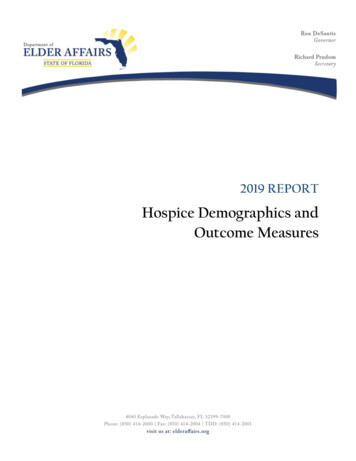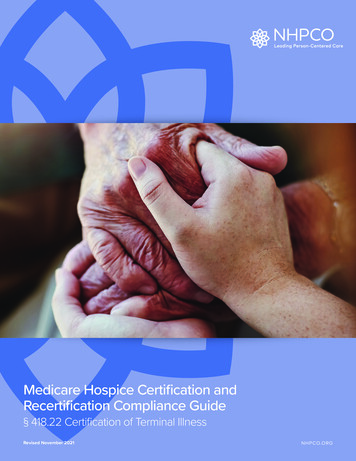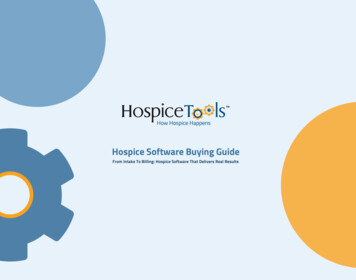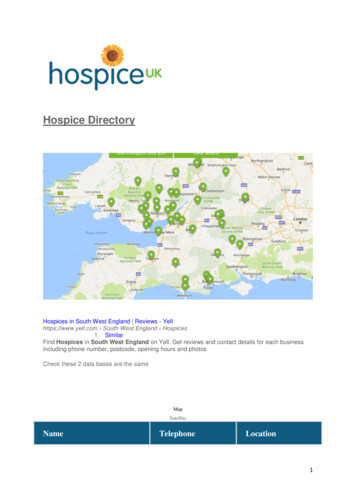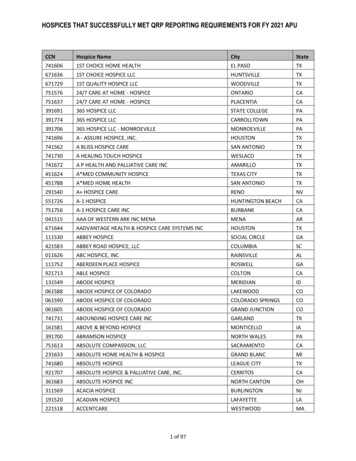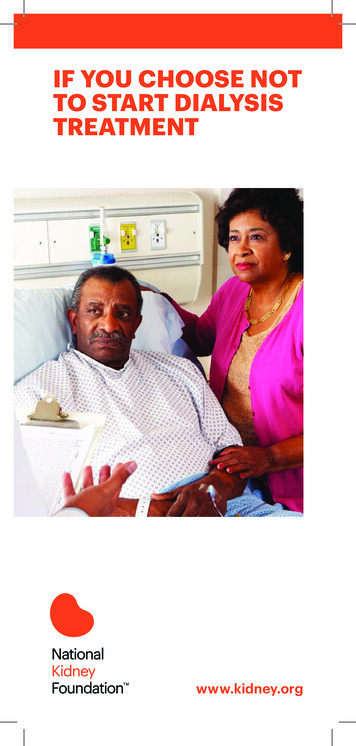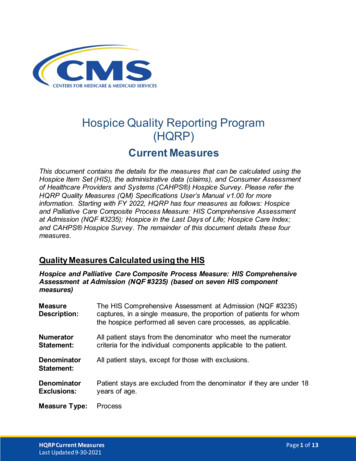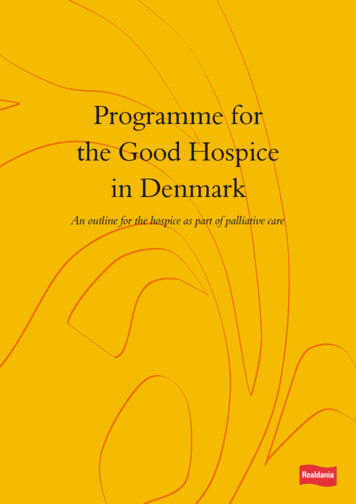
Transcription
Programme forthe Good Hospicein DenmarkAn outline for the hospice as part of palliative care
Programme forThe Good Hospicein DenmarkAn outline for the hospice as part of palliative carePrepared in 2005/2006 by SIGNAL architects for the Realdania Fund incollaboration with the steering group for the project:Anne Nissen (chairperson), Head of Department, Master of Science Social Work, The Danish Cancer SocietyHelle Tingdrup, RN, Head of Hospice, Chairperson for the union of heads of hospice, palliative teams andpalliative departments in DenmarkLisbeth Due Madsen, RN, Master of Science Nursing, member of the executive committee forthe Association for Palliative Care - Care at the end of lifeKnud Ole Pedersen, RN, previous head of KamillianerGaardens HospiceLise Pedersen, leading chief physician, dr.med., Chairperson of Danish Society for Palliative MedicineMarianne Kofoed, Project leader, Fonden RealdaniaOle Bang, Business consultant, Chairperson of Hospice Forum Denmark 2001-2006Consultants:Gitte Andersen, Director SIGNAL architectsHospice Innovation DKProject leader:Patrik Mattias Gustavsson, SIGNAL architects
Table of ContentsPreface by Tove Videbaek, chairperson of the Hospice Forum Denmark . . 4Preface by Anne Nissen, chairperson of the steering group. 5Resume. 7Introduction. 9Gathering of experiences. 10I. A historic overview. 11II. The hospice and the future. 18III. What can we learn from others?. 31Focal areas and recommendations. 66Space programme. 75I. Design principles for The Good Hospice in Denmark. 76II. Examples of programming. 82III. Suggestions for an ideal implementation process. 105Conclusion. 109Bibliography and References. 111Attachments. 115
PrefaceTove Videbaek, chairperson of the Hospice Forum DenmarkSince The Programme for the Good Hospice in Denmark was publishedin February 2006, the development of the hospice situation in Denmark hasadvanced very rapidly.Never before have so many hospices been built in Denmark during one year.Never before have so many hospice beds been made available in our country.Never before have so many hospice buildings been on the Danish drawing-boardas there are now.In Hospice Forum Denmark we are grateful for the new ‘hospice law’ ofDecember 2004, and subsequently for the publication of The programme forthe Good Hospice in Denmark. We appreciate very much the great work doneby the steering group, the entire reference group, the leader of the project, thearchitects, and the Danish Realdania Fund, who initiated the project and madethe publication possible.Hospice Forum Denmark consider The programme for the Good Hospice inDenmark to be of such a high quality, so innovative and of such great value, thatwe have decided to translate it into English to make it available internationally.Thanks to donations from Lions Club Soeborg, Denmark (Member of TheInternational Associaton of Lions Clubs), this translation and distribution hasbeen made possible. Furthermore we owe thanks to the translator, Anne-BirgitteMullins, and to the proof-reader, Dr. Jonathan Rout, Reading (UK), for theirwork.Our intention with the English edition of The programme for the GoodHospice in Denmark is to inspire and create renewal in the area of establishingand renovating hospices around the world. We hope that this project may profitterminally ill and dying human beings and their carers all over the world.The programme will be updated continually during the coming years to reflectthe experiences we gain. You will always be able to find the latest English versionof The programme for the Good Hospice in Denmark on the website ofHospice Forum Denmark (www.hospiceforum.dk).Best wishes,Tove VidebaekJanuary 2007
Original Preface to the Danish VersionAnne Nissen, Chairperson of the steering groupTaking leave of life requires the best conditions for the dying person as well asfor the relatives. The hospice is exactly the philosophy and care which ‘re-thinks’values and framework for the end of life in our time.The hospice has the patient and his/her relatives in focus. The thought behindthe hospice places death on the agenda, - death which we are all going to experience, but which we prefer to deny, because it hurts having to let go of life and ofthe people we are close to.When the debate about the hospice in Denmark began, it was said that the ‘hospitals of death’ did not fit into Danish mentality. But after the opening of SanktLukas Hospice in 1992, the first hospice in Denmark, this attitude changed. People experienced that death in a hospice was different from death in hospital. Thefocus is on care and closeness and also on palliative care and relief from othersymptoms. The hospice became a popular issue. All over the country the population supported local hospice initiatives.In December 2004 a new ‘hospice law’ was passed in Parliament. All countiesare obliged to enter into a working agreement about 12 hospice beds with a localhospice initiative. This decision has pushed the development of the hospice inDenmark forward. It means that there is now a very definite focus on the conditions which we, as a society, can offer the terminally ill and dying human being.A hospice accommodating 12 beds cannot meet the needs of all terminally illpatients, nor is it meant to. The needs of people differ facing death and dying.Therefore the hospice is intended as an integral part of the complete packageavailable to the terminally ill and their relatives. The hospice cannot stand alone.The hospice is an institution and a part of our hospital system, but with a different focus. Therefore the form should be different. Contents and form mustinteract in a new way to reach the goal, - quality in life, both for the dying and forthe relatives.Project The Good Hospice in Denmark is a wish to create renewal within the Danish building of institutions. A wish to create a synthesis of form, contents andneeds, which supports the users of a hospice, from the human, professional, andarchitectural angle. In its capacity as initiator of the project, the Realdania Fundhas attempted to break new ground.In order to stretch our understanding of what a hospice is and to ensure a multiprofessional quality in this understanding, we have held two workshops with areference group with a particular mix of members. In the group there are, among
others, representatives for future hospice projects, hospice leaders, hospitals, doctors, nurses, architects, engineers, artists, priests and relatives.In order to ensure the high ambitions and the professional quality of the project,this has been developed in close cooperation with the steering group of theproject.Big thanks to the members of the steering group for their competent and committed work. The work and the discussions of the group have been carried by thededication, which characterises the hospice work. Also a word of gratitude to theentire reference group, which has contributed to the manifestation of the reportin various workshops held during the development of the project. We would liketo express particular gratitude to the ‘Kamillianer Gaarden’ Hospice in Aalborgand to the English hospices we have visited: The Hospice of Saint Francis, NewFarleigh Hospice, The Princess Alice Hospice, Grove House and the organisationHelp the Hospices in London. These organisations have joyfully shared their vastknowledge and experiences with us. And thank you, too, to the many people whohave contributed to the contents of the report in other ways.A special thank you to the leader of the project The Good Hospice, Patrik MattiasGustavsson, SIGNAL architects, for his inspiring cooperation.We are looking forward to implementing the programme The Good Hospice in anumber of new hospices in Denmark. The programme will be updated continually in the coming years, in tandem with the experiences we gain. You will alwaysbe able to find the latest version on the Internet at the website of the RealdaniaFund (www.realdania.dk).Enjoy reading!Anne NissenFebruary 2006
ResumeThe shape of the physical framework has considerable influence on the quality ofcare perceived by patients, their relatives, employees and volunteers, who workand stay at a hospice.This is the main conclusion in this report, which describes how The Good Hospicein Denmark could look and function, with the physical framework as a focalpoint.The report highlights the potential within the intentional shaping of the physicalframework so this works as an active element, contributing to an improved qualityof life for the patients and their relatives at the end of life, while supporting theinformation intensive work performed by the employees at a hospice.The goal with the project The Good Hospice in Denmark was to work out aprogramme, which could serve as inspiration for future hospice projects indifferent parts of the country, and as a tool in the planning of new hospices or inextending already existing ones.The report is aimed at consultants, decision makers, architects, engineers, projectleaders and steering groups for local hospice projects; it is intended as inspiration,as a manual and a checklist to ensure that sufficient thought has been given to thepurpose, function and expression of the physical framework.The programme for The Good Hospice highlights eight focal areas, which areessential to focus on in order to create optimal conditions for patients, relatives,volunteers and the employees at hospices in Denmark.1. To ‘re- think’ and professionalize the phase of creation so this, to a higherdegree, involves the users early on in the process, gathers already existinginformation and ensures that the initial intentions are considered, rightfrom the first phase of ideas through to the construction of the newhospice building.2. To create a powerful culture where the particular hospice philosophyserves as a platform for palliative care at a hospice and contributes tocreating the spirit, which forms the backdrop for a good stay for the usersof a hospice.3. To improve and develop inter-organisational and interdisciplinarycooperation, as this is a condition for patients and relatives to experiencepalliative care as a unified whole.4. To re-think the patients’ ward so this supports the differences, wishes andneeds of individual patients.5. To work with the hospice building as an agent for active support andpromotion of the desired atmosphere, which adds to the creation of abetter stay for patients, relatives, volunteers and employees at a hospice.6. To allow the physical framework to facilitate social interaction betweenpatients, relatives, volunteers and employees at a hospice, to a largerdegree.
7. To utilise the volunteers to a higher degree, as these fill an importantsocial function for patients and their relatives and build bridges betweenthe surrounding local community and the hospice.8. To improve the framework for the information intensive work processesso that the hospice building supports and promotes sharing of knowledge,exchange of experience and interdisciplinary cooperation, to an evenlarger degree.The focal areas and the related recommendations are used as a foundation for agroup of design principles, which offers a direction for the construction of thephysical framework for The Good Hospice.The principles are intended as tools for the programming/planning of a newhospice and deal with the functional demands, the mutual relations of thedifferent parts and the varying types of ambience and expressions some of thecentral spaces should promote.The programme is to be seen as a living and dynamic document, which will beupdated and adjusted continually, in tandem with the gaining of new experiencesin the field, in the coming years.
IntroductionIn the middle of 2005 the Realdania Fund initiated the project The Good Hospice inDenmark with the aim of gathering the experiences which have been gained within thehospice area in Denmark, while at the same time providing a forward looking estimateof how the hospice of the future could look. The programme for The Good Hospice inDenmark is aimed at consultants, decision makers, architects, engineers, project leadersand steering groups for local hospice projects, and it is intended to serve as inspiration,manual and checklist to ensure that sufficient thought has been given to the intention,function and expression of the physical framework in connection with planning andestablishing new hospices.In order to create a building which functions and works optimally, it is necessary tohave a deeper understanding of the actual purpose of the building, the needs andwishes of the users of the building and the work processes which are to take place in it.This is the reason we have chosen to set out the programme in a slightly untraditionalway.The first part sets the stage for the actual ‘space programme’ and places the conceptof the hospice in a historical and future context. We are here looking at the historicalroots of hospices in order to glean knowledge of why we are exactly where we aretoday.Here we also look into the future and consider the developing trends we think areimportant to consider when planning a new hospice. Furthermore, we look at thegood examples we already have in Denmark and in the international society in orderto estimate what we can learn from others. The entire first part concludes with a listingof the focal areas we consider relevant to focus on in order to create a good hospice inDenmark.The second part of the programme goes into further details in the focal areas, and herewe present our suggestions for the principles which are to form the foundation of thephysical framework of The Good Hospice. The principles are intended to be tools inthe programming and planning process of a new hospice, and address the functionaldemands, the mutual relations of the different parts and the ambience and expressionssome of the central rooms in the hospice should facilitate. Finally we bring an exampleof a programming of the physical framework of The Good Hospice, where the abovementioned principles are put into practice.The programme has been developed on the basis of a large number of interviews with,and visits to, representatives of Danish and English hospices, conversations, interviewsand workshops with relatives, architects, priests, nurses, doctors and other consultantsand users of hospices, as well as studying relevant literature within this field.The overriding aim with the programme is to create better stays for the terminally illand their relatives during a difficult period and a well functioning workplace for thevolunteers and the staff at hospices in the country.Enjoy reading!Patrick Mattias GustavssonSIGNAL architects
Gatheringof experiencesThe purpose with this section is to create a frame of reference and to set the stagefor the recommendations of the programme regarding the physical frameworkfor The Good Hospice.The section consists of three chapters:A historic overview, where we describe how the concepts of the hospice and palliative care have emerged in recent years - in Denmark as well as internationally.A review of some trends and development within the palliative field, which couldbecome significant in the future development of palliative care and the hospice aswell as a financial analysis of The Good Hospice.Finally comes an account of examples of how others have chosen to work withthe hospice, both in Denmark and internationally, and a resume of what we canlearn from others in the planning and shaping process of a new hospice.10
I. A Historic OverviewThe development of the hospice philosophy and palliative care are expressions ofa holistic approach to care, which over and above the relief of the physical symptoms of the patient also deal with the psychological, social and existential/spiritualproblems of the patient and the relatives. The aim is to improve the quality of lifeof the terminally ill, the dying and their relatives. The two concepts, the hospiceand palliative care overlap each other, and therefore it is not uncommon that thehospice is used both as a description of a concrete, physical building, which provides the framework for caring of the terminally ill, while it is also perceived as aphilosophy, describing the approach to caring.The philosophy regarding special care for the dying has existed for more than athousand years, in a cross section of cultures and countries. The philosophy aswell as the concrete approach has been developing constantly all this time.Palliative CareThe development in society, and the advances in the medical and medicinal/ technological area are the reason that we have far more medical treatment methodsfor treating seriously ill patients at our disposal today than previously. Quite simply, we have become better at diagnosing and treating diseases, and today it is possible to heal more diseases than previously. Palliative care becomes relevant whena disease is diagnosed as terminal.The purpose of palliative care is to alleviate symptoms and suffering linked toterminal diseases. It encompasses the entire interdisciplinary nursing, care andtreatment offered to the terminally ill, the dying and their relatives. The conceptcovers thus both a clinical approach, a psycho-social and an existential approach,which together aim at relieving physical symptoms or suffering of a psychological, social and existential/spiritual character.Palliative care thus encompasses more than traditional pain relief and medication.It also focuses on the psychosocial and existential/spiritual needs of the patientand the relatives. For that reason the work is based on a high level of cross- professionalism and interaction between many different professional competences;doctors, nurses, psychologists, priests, physiotherapists, dieticians, social workers, music therapists etc. Great emphasis is placed on using the individual patientand his/her relatives and their particular situation and needs as a starting pointrather than offering ready-made package solutions based on the terms of the system. Palliative care is care with the patient at the centre and it emphasises theinvolvement of the patient and the relatives when choosing the specific treatmentmethods, the actual nursing and care and other important decisions, which aresignificant in their situation. Palliation i primaersektoren, Dansk Selskab for Almen Medicin, Asbjoern Ziebell et. al.,2004 p.811
When you talk about palliative care, it relates to the period when healing (curative) treatment gradually ceases until physical death occurs. Terminal care is careoffered to the dying during the last days or weeks, and it thus only represents apartial period of palliative care. Previously, the description terminal care was considered synonymous with palliative care , which, time wise, shortened the periodwhere the patient benefited from palliation.A Historic overview of the HospiceThe word hospice can be traced back to the Middle Ages, where it referred to aplace where travellers and the sick could find hostel and protection. The wordhospice derives from the Latin word hospitium, which freely translated means “aresort for travellers”. The hospice of the present day can be defined as “a houseoffering care and quality of life for the terminally ill and the dying as well as theirrelatives.”From the early 1800s the hospice was used by Madame Jeanne Garnier as a description for care for dying patients. In 1842 she founded the hospice ‘Dames deCalvaire‘ in the south east of France, which was followed by a hospice for thedying in Lyon the following year. In Ireland the concept was introduced in 1879at the opening of “Our Lady’s Hospice” in Dublin. Other historical institutionswere ‘St. Luke’s Hospital’ in England, which opened in 1893 and ‘St. Joseph’sHospice’ in Hackney, which opened in 1905. The nurse, socialworker and doctor Dame Cicely Saunders founded the modern hospice movement. She formulated and developed the hospice philosophy,which is now a description of the specialised care of the dying. In 1967 CicelySaunders founded the first hospice in modern time – ‘St. Christopher’s Hospice’in Sydenham, a suburb of London.The Development of The Hospice and Palliative Care in other countriesIn England the hospice developed as a concept for separate units with beds forthe care of dying patients. These units were primarily available for cancer patientswith complex symptoms and psychosocial problems, which did not “fit into” thetraditional healthcare system. The patients were typically in the terminal phase,with an expected lifetime of a few weeks.Two problems quickly emerged in the work around the hospice. Firstly, therewere many patients who wished to be taken care of and die at home. In orderto meet those needs and supplement existing services, a kind of visiting hospiceteam was developed, which offered help as consultants and assisted the homecare. Secondly, a need was identified to establish particular teams, which were topass on their expertise gained from the experiences with the hospice to patientsand relatives in other surroundings, for example hospitals.In England most people link the hospice concept primarily with places in an institution and day beds. A few hospices have their running costs completely covered Palliation in primaersektoren, Dansk Selskab for Almen Medicin, Asbjoern Ziebell et. al., 2004 p.9Hospice and Palliative Care - Facts and Figures 2005, Help the Hospices, p.212
by National Health Service (NHS), but by far the most depend on voluntarywork and donation of up to 80 % of the total running costs in order to exist. Oneconsequence of this is partly that you employ professional fundraisers, but alsothat the choice has been made to involve many more volunteers than we are usedto in Denmark. A typical hospice engages between 500 and 800 volunteers. Thevolunteers are also far more involved in the daily work, and there are examples ofvolunteers who prepare the food, work as hairdressers, receptionists or carry outchiropody etc.Today palliative care in England has become a common description for palliativecare carried out in hospices, hospice day-centres, in patients’ homes (or “in thehome”) and in specific hospital wards. In 2005 there were 253 hospices in England, with a total of 3,411 beds. Of these,33 hospices with a total of 255 beds are reserved for children. Recently specificday-centres have been developed, which partly function as relief for the relatives,but also as a social service for the patient - with the possibility of getting help withrelief of symptoms. These day-centre functions can be integrated in the traditional hospice or be independent units with close cooperation with other hospices.The Historic Development in the USAIn the USA palliative care emerged as a service in the patients’ own homes. Theearly hospice movement was established outside the traditional healthcare system. The development was organized in 1982, when a law was passed regardingthe coverage of the expenses for hospice care and treatment in the home for participants in the national healthcare insurance programme, Medicare.An attempt was made to imitate the English model with a combination of hospicebeds and visiting teams with limited success. In the beginning Medicare did notsee possibilities in the extension of the hospice service, which included particularwards for patients whose needs could not be met at home.Due to the lack of knowledge and competence in palliation in the hospitals, palliative teams experienced that it was difficult to deliver good service to those patients who needed it in connection with hospitalisation. Consequently, an effortwas made to develop specific beds dedicated to this particular group of patients.In January 2001 there were approx. 2,200 hospices in the USA. It is estimated thatanother 200 hospices run primarily by volunteers exist, over and above this. Thedevelopment thus started in the patients’ own home and from there palliativeservices were developed to also include hospices with specific beds.The Historic Development in DenmarkIn Denmark the hospice and palliative care were placed on the agenda in earnestin the 1990s. In 1996 accession was made to the aims of the WHO for palliativecare, which were to be offered to all terminally ill and dying patients, regardlessof whether they were in their own home, at hospital or at a hospice. The NationalCentre to advance palliative care (CAPC), CAPC Manual, hpc.html, lastvisit 09.01.06 Help the Hospices, www.helpthehospices.org., last visit 09.01.06 National Association for Home Care and Hospice, www.nahc.org, last visit 09.01.06 13
Health Service recommended a unified organization of palliative care in countiesand municipalities, so the care was available on a basic as well as on an expertlevel. The establishment of specific palliative expert teams was suggested with the purpose of assisting the dying, their relatives and professionals, when terminally illand dying patients stayed at home or in hospitals. In 1999 the National HealthService worked out professional guidelines for palliative care in Denmark. At a basic level palliative care includes the relief work taking place in the commonhospital wards and at home. At this level professionals must know the fundamental principles and attitudes of palliative care as part of their entire work area.Palliative care at expert level is aimed at patients with complex symptoms, whichdemand specialised and/or interdisciplinary care. This care is rendered at hospicesor in palliative units/wards at hospitals, but also in the patients’ own homes or innursing homes via visiting palliative teams. The expert care is undertaken by aninterdisciplinary group of professionals, who must know all aspects of palliativecare and who work exclusively within the palliative area.Sankt Lukas Hospice in Hellerup, which opened in 1992, is the oldest in thecountry and it was also here the first home hospice opened in 1997, consisting ofa visiting specialist team with consulting functions within palliation, aimed at theterminally ill and dying patients and their relatives. This was considered a supportfor care in primary sector and under hospital management.Hospices in Denmark – an overviewIn December 2005 there were seven hospices available in Denmark: Sankt LukasHospice in Hellerup (1992), Sct. Maria Hospice Center in Vejle (1995), Diakonissestiftelsens Hospice in Frederiksberg (1997), KamillianerGaardens Hospicein Aalborg (1999), Hospice Soeholm in Aarhus (1999), Hospice Fyn in Odense(2004) and Arresoedal Hospice in Frederiksvaerk (2005). More hospices are underway in the remaining counties.Furthermore, Bispebjerg Hospital has a palliative care unit with 12 beds, andother smaller palliative care units exist at other hospitals.The actual hospice idea as well as palliative care is relatively new concepts in Denmark. As already mentioned these have only been developed as a professional areawithin the last 10-15 years. The National Health Service has pointed out that theexisting information about the possibilities available within palliative care today isnot sufficiently diffused among the healthcare staff, neither is it communicated topotential patients and relatives to the required degree One of the challenges today is therefore to develop services of palliative care for patients, so they becomeequally available for all patients and relatives, regardless of their physical locationin the country.Wagner, Lis et.al. Palliativ indsats i Danmark. DSI rapport 1997Sundhedsstyrelsen. 1999. Faglige retningslinier for den palliative indsats. Sundhedsstyrelsen, Kraeftplan II, juni 2005, p.52 14
In the year 2003-2004 a collaborative initiative took place between KraeftensBekaempelse [The Danish Cancer Society], Hospice Forum Danmark [Hospice Forum Denmark], Foreningen for Palliativ Indsats [Association of Palliative Care] andDansk Selskab for Palliativ Medicin [The Danish association af Palliative Medicine]with the aim of diffusing the hospice idea and ensuring more hospice services topatients, so admission to a hospice can become a real alternative to hospitalisationor staying at home. Another part of this initiative aims at coordinating and developing the quality of palliative care.Palliative teamsA palliative team is an interdisciplinary group, consisting of doctors, nurses,physiotherapists, social workers, psychologists and priests, who have specialisedknowledge about palliation.10 The objective of a palliative team is to contributeexpert assistance to patients and relatives in the home, who need palliative care,in collaboration with practising doctors and district nurses. The palliativ
the Good Hospice in Denmark. We appreciate very much the great work done by the steering group, the entire reference group, the leader of the project, the architects, and the Danish Realdania Fund, who initiated the project and made the publication possible. Hospice Forum Denmark consider The programme for the Good Hospice in


